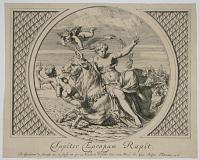Results 1-3 of 3
<<< Previous 1 Next >>>
![['He who easily believes, is easily deceived']](img-thumbnail/jpegs/41710.jpg)
['He who easily believes, is easily deceived'] Qui facile credit facile decipitur. Die licht geloogt wort licht bedrogen.
Per Gerardum de Lairesse inv: et sculp: et Per Nicolaum Visscher edit: cum Priv: Ord: Gen: Belgii Federati [1668]
Etching, 17th century watermark; platemark 185 x 130mm (7¼ x 5"), with very large margins.
Man lifting the lid of a plate, with two people stood behind laughing at him. Illustration to Act One of Andries Pels' comedy 'Julfus' (Amsterdam, 1668). Etched by Gérard Lairesse (1640-1711), Dutch painter and etcher who worked for William and Mary amongst other illustrious patrons. A classicist and theorist (after going blind he wrote a major theoretical treatise, the Groot Schilderboek or 'Great Book of Painting'), Lairesse was known as the 'Dutch Poussin'. Most of his plates were originally published by Nicolaes Visscher, who published a collected edition under the title 'Opus Elegantissimum' in c.1675.
[Ref: 41710] £240.00
(£288.00 incl.VAT)

Jupiter Europam Rapit. Per Gerardum de Lairesse inv. et sculp. et per Nicolaum Visscher edit. cum Privil. Ord. Gen. Belgii Foederati.
[n.d., c.1770s.]
Etching, sheet 240 x 295mm. 9½ x 11¾". Trimmed to plate.
The rape of Europa, with Jupiter as a bull bearing her off across the water; Europa who sits on his back, her hand in the air, accompanied by two erotes. In a circular frame. Europa was a Phoenician woman of high lineage in Greek mythology, from whom the name of the continent Europe has ultimately been taken. A myth tells of her abduction by Zeus in the form of a white bull. Europa's earliest literary reference is in the Iliad, which is commonly dated to the late 9th or to the 8th century BC. After Gérard de Lairesse (1641 - 1711)
[Ref: 22281] £230.00
(£276.00 incl.VAT)
![[William III when Prince of Orange]](img-thumbnail/jpegs/43009.jpg)
[William III when Prince of Orange] Dit's Welhem's Laasten Naam, en's eersten Deugdgenoot; / Goot om zyn Stam, en om zyn eigen Waarde groot [...]
Per Gerardum de Lairesse inv: et sculp:
et Per Nicolaum Visscher edit cum priv: Ord: Gen: Belgii Foederati nunc G. Vall [c.1672]
Etching, sheet 235 x 155mm (9¼ x 6"). Trimmed; tipped into album sheet.
William III (1650 - 1702) when Prince of Orange, wearing armour and laurel headdress, in oval frame alongside the trumpeting figure of Fame. Son of stadholder William II of Holland and Mary, daughter of Charles I, William married his cousin Mary, daughter of James II and Anne Hyde in 1677. In 1688 he accepted an invitation by a group of leading statesmen to land in Britain with an armed force (the 'Glorious Revolution'). In 1689, after the flight of James II, he was crowned jointly with his wife. Etched by Gérard Lairesse (1640-1711), Dutch painter and etcher who worked for William and Mary amongst other illustrious patrons. A classicist and theorist (after going blind he wrote a major theoretical treatise, the Groot Schilderboek or 'Great Book of Painting'), Lairesse was known as the 'Dutch Poussin'. Most of his plates were originally published by Nicolaes Visscher, who published a collected edition under the title 'Opus Elegantissimum' in c.1675.
[Ref: 43009] £190.00
(£228.00 incl.VAT)
<<< Previous 1 Next >>>
![['He who easily believes, is easily deceived']](img-thumbnail/jpegs/41710.jpg)

![[William III when Prince of Orange]](img-thumbnail/jpegs/43009.jpg)